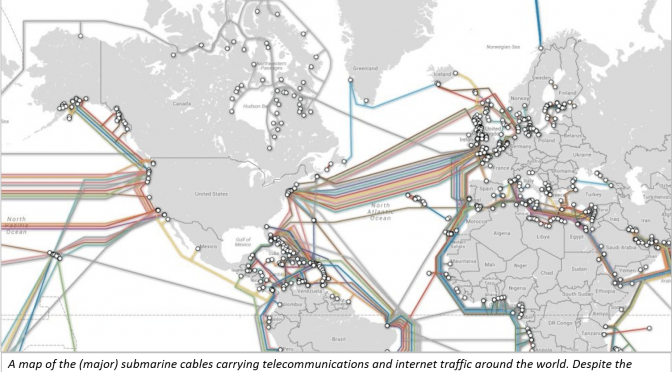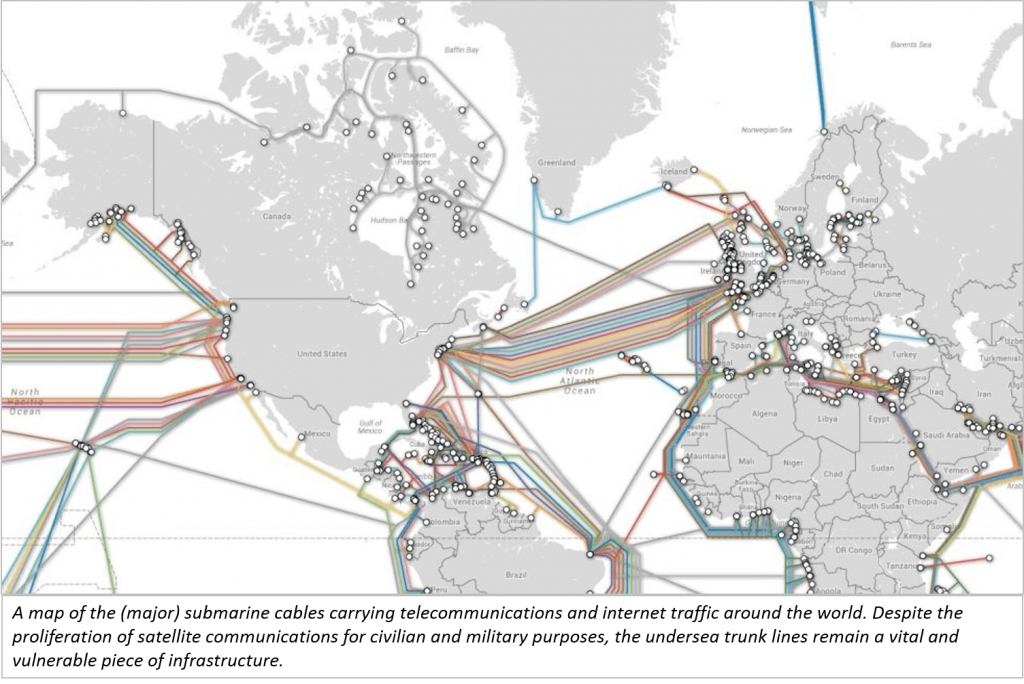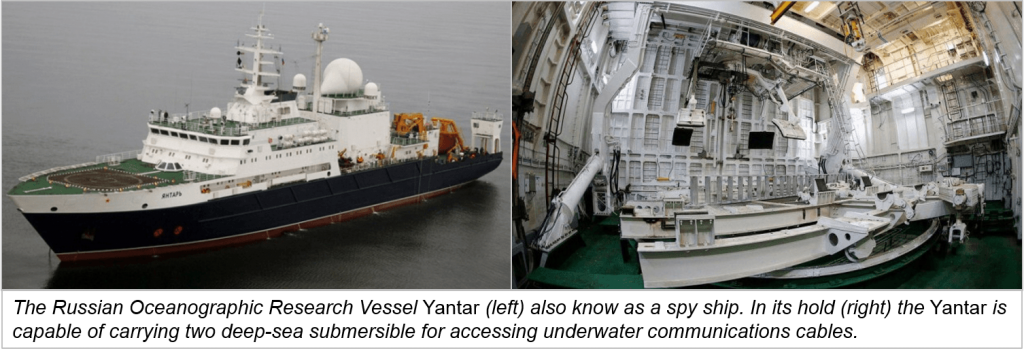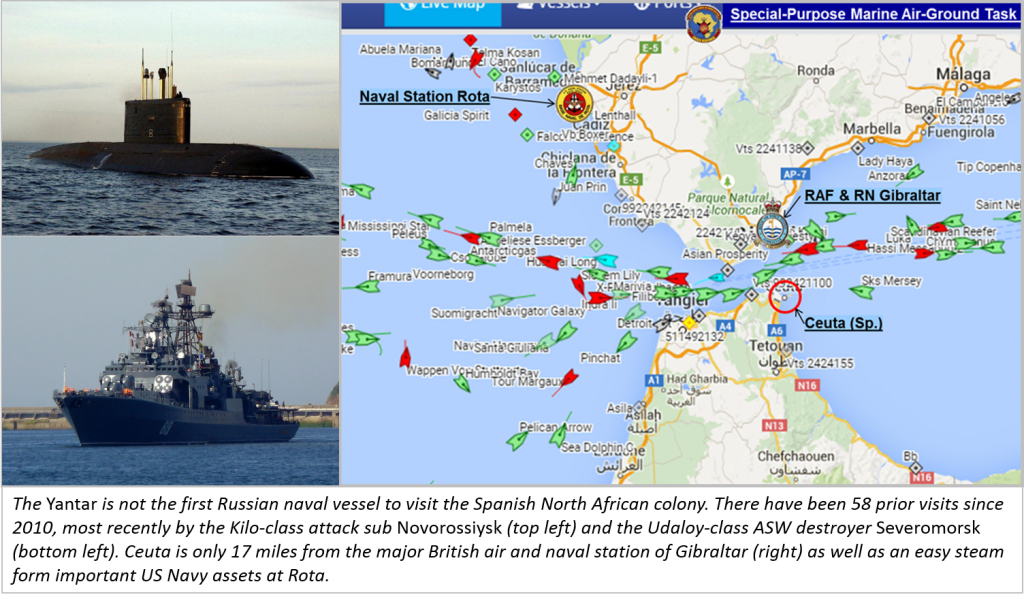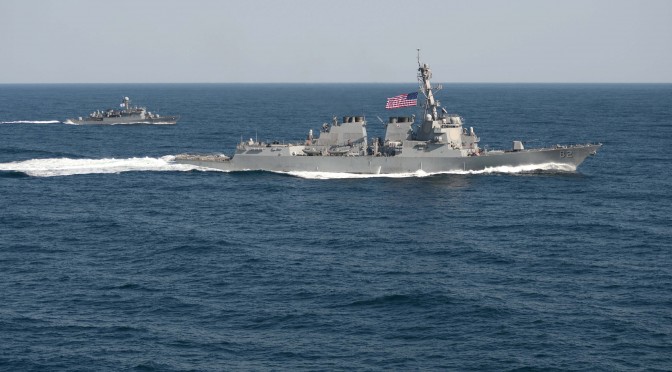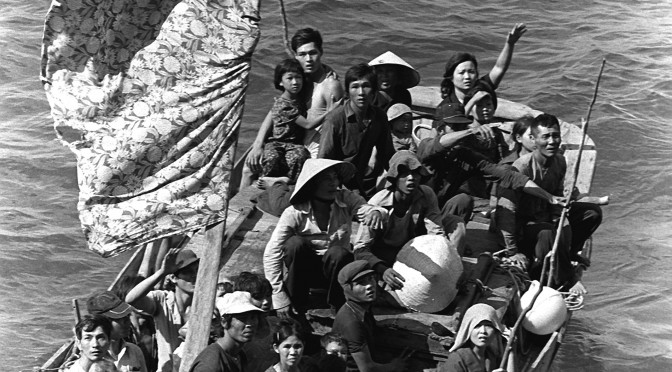Category Archives: Current Operations
On-going Naval Ops or Maritime Current Events
An Update on Narco Submarines and Maritime Law Enforcement Agencies’ Efforts to Thwart Their Operational Effectiveness
This article originally appeared on the Small Wars Journal, and has been republished with permission. You can read it in its original form here.
By Byron Ramirez and Robert Bunker
During recent months, media outlets have dedicated special coverage to the latest narco submarine seizures carried out by the U.S. Coast Guard and other partner agencies. In our 2015 Foreign Military Studies Office report, Narco-Submarines: Specially Fabricated Vessels Used for Drug Smuggling Purposes, we discussed the strategic implications associated with this innovative method of transporting narcotics. We explained that narco submarines originated in the early 1990s and have been used since then as an alternative to other less covert methods of distribution. Over time, narco submarines’ design, features, and technical capabilities have continued to evolve. This advancement in technology has certainly presented challenges to law enforcement authorities and militaries. Nonetheless, in spite of the evolution of narco submarine technology, the U.S. Coast Guard and U.S. Navy have developed their own sophisticated set of technologies which allows them to improve their ability to detect and capture these vessels.
Who: Drug cartels, especially many based in Colombia, manufacture narco submarines.
What: Narco submarines are used to transport narcotics from Colombia to other countries in Central America as well as Mexico.
When: This method of distributing narcotics became more prominent around the year 2006. A larger number of narco submarines have been seized since around 2007, mostly in the Pacific Ocean, with a smaller number in the Caribbean Sea. [1]
Where: Drug traffickers have used mostly low profile vessels (LPVs) to transport narcotics from Western Colombia and Northwest Ecuador to Central America, frequently via the Pacific Ocean. The majority of these vessels travel past Panama, Costa Rica, and Nicaragua, and often are intended to reach other countries in Central America as well as Mexico, where their merchandise is then collected and re-routed to other destinations via other delivery methods.
Why: Because of their technical features and low profile design characteristics, narco submarines allow drug traffickers to reduce the risk of detection and seizure. Although there have been several confiscations, it is believed that many of these vessels continue to travel undetected and ultimately reach their intended destinations.
Synopsis
Incident 1: On June 2, 2015, the USS Kauffman [FFG-59] seized 582 kg. of cocaine from an Ecuadorean semi-submersible that was traveling in the Pacific Ocean. The vessel was intercepted near Guatemala. The three crewmen included two Ecuadoreans and one Colombian. [2] A later article placed the seizure at 779 kg with a street value of USD$15.5 million. [3]
Incident 2: On July 19, 2015, the U.S. Coast Guard Cutter Stratton [WMSL 752] intercepted and captured a 40 foot long, semi-submersible, low profile vessel in the Pacific Ocean which carried more than 16,000 pounds (over 6 tons) of cocaine. According to reports, the seized narcotics are worth more than USD$180 million wholesale. This represented the largest seizure of its kind in U.S. Coast Guard history at the time. The vessel was detected by U.S. Navy maritime patrol aircraft in international waters about 200 miles south of Mexico. CBS reports that the same U.S. Coast Guard crew which intercepted this vessel has also intercepted 15 other drug smuggling vessels since April 2015, and has seized over 33,000 pounds of cocaine worth over USD$540 million since May 2015. [4]
A Coast Guard Cutter Stratton boarding team seizes cocaine bales from a self-propelled semi-submersible interdicted in international waters off the coast of Central America, July 19, 2015. The Coast Guard recovered more than 6 tons of cocaine from the 40-foot vessel. (Coast Guard photo courtesy of Petty Officer 2nd Class LaNola Stone)
![9 July 2015 Seizure of Narco Submarine U.S. Coast Guard Image from Video [FOR PUBLIC RELEASE] U.S. Agencies Stop Semi-Submersible, Seize 12,000 Pounds of Cocaine 94th Airlift Wing, U.S. Coast Guard Pacific Area. DVIDS/DMA, 19 July 2015.](https://cimsec.org/wp-content/uploads/2015/11/sub2.jpg)
[FOR PUBLIC RELEASE] U.S. Agencies Stop Semi-Submersible, Seize 12,000 Pounds of Cocaine 94th Airlift Wing, U.S. Coast Guard Pacific Area. DVIDS/DMA, 19 July 2015.
With respect to this same narco submarine seizure, The Washington Times [5] reported:
“Our extremely efficient and experienced aircrews are fully engaged in protecting the United States’ maritime borders from all threats including those posed by drug trafficking organizations,” said Director of National Air Security Operations Center — Jacksonville Robert Blanchard. “Our collaborative interagency partnerships and long-range tracking capabilities allow us to interdict dangerous vessels before they reach our coastal borders.”
Meanwhile, The Washington Post [6] stated:
“The July effort (interdiction) marked the second time that the (U.S. Coast Guard Cutter) Stratton had stopped this type of narco-submarine in a two-month span. In June, the Stratton crew also stopped a submersible carrying 5,460 pounds of cocaine.”
Taking part in this July 19 interdiction was the U.S. Navy, U.S. Coast Guard, and the U.S. Customs and Border Protection (CBP) Office of Air and Marine (AMO). This joint operation off the coast of El Salvador shows the collaboration taking place across agencies to thwart drug trafficking operations. [7]
Incident 3: On August 31, 2015, the U.S. Coast Guard seized yet another semi-submersible in the eastern Pacific Ocean. This particular seizure by the USCG Bertholf [WMSL 750] represented nearly 15,000 pounds of cocaine. The vessel was 50 feet long and carried a 4 person crew. It is estimated that the value of this shipment, which was captured west of Mexico, is approximately USD$227 million. The vessel was spotted by U.S. maritime patrol aircraft and intercepted by two long-range U.S. Coast Guard interceptor boats. [8]

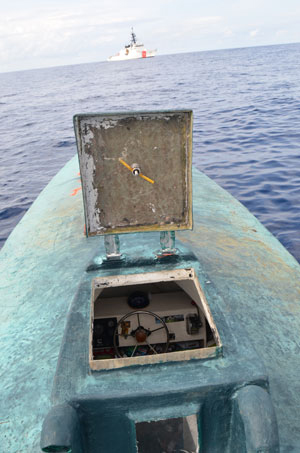
Incident 4: In September 2015, Colombia’s navy captured a semi-submersible that was being prepared to be launched into the Pacific Ocean. According to the official report, the vessel was 12 meters long, 3 meters wide, and could carry 5 tons of narcotics. It is believed that this vessel was built by FARC in the southwestern region of Colombia. [9]
Analysis
As we indicated in our 2015 FMSO report, low profile vessels can mask their heat signature, evade sonar and radar, and use lead siding to help mask their infrared signature. These particular technical aspects make their detection and capture exceedingly difficult and have forced law enforcement authorities to design their own technology and methods that counteract this technological race.
The U.S. Coast Guard has increased its technological capabilities as it attempts to intercept drug running vessels in both the Gulf of Mexico and in the Pacific Ocean. The Coast Guard is collaborating with the U.S. Navy and other agencies as well as utilizing military surveillance aircraft and nuclear fast attack submarines to search for narcotics carrying vessels. The Coast Guard has also been using HC-130 Hercules aircraft which provide surveillance and tracking of drug trafficking vessels in the Pacific Ocean. [10]
The U.S. is also working through the Joint Interagency Task Force (JIATF) South, a component of SOUTHCOM composed of multiple federal and partner nation agencies and military forces. Together, these agencies carry out detection and monitoring operations and share information that supports law enforcement interdictions of illicit trafficking. [11]
It is difficult to determine how many drug carrying vessels are currently being deployed and which specific routes they are using. Drug traffickers realize that there are risks involved with these operations, yet they consider captured vessels as a cost of doing business. In spite of the interdictions to date, we can suppose that drug traffickers continue to use this transportation and delivery method as it continues to yield high profits even when seizures are factored into the cost-benefit analysis.
The efforts carried out by the Joint Interagency Task Force (JIATF) South, including the U.S. Coast Guard and the U.S. Navy, must continue to reconcile the complexity of the challenges presented by evolving narco submarine technology and the ingenuity of drug trafficking organizations.
Collaboration and communication between law enforcement agencies and militaries are imperative to improving the efficiency and effectiveness of ongoing interdiction efforts. Although detection and monitoring technology have improved, this alone is not sufficient. In order to more accurately disrupt drug trafficking operations, governments and their law enforcement agencies must improve their exchange of intelligence and share best practices that enable them to adjust to the dynamic counter actions introduced by drug traffickers.
Sources
[1] Byron Ramirez, and Robert J. Bunker, Narco-Submarines: Specially Fabricated Vessels Used For Drug Smuggling Purposes. Fort Leavenworth, KS: U.S. Army Foreign Military Studies Office (FMSO), 2015, http://fmso.leavenworth.army.mil/Collaboration/Interagency/Narco-Submarines.pdf
[2] Lic. Marco Proaño, “Embarcación ecuatoriana fue capturada con 582 Kg de droga.” Armada del Ecuador. 15 June 2015, http://www.armada.mil.ec/embarcacion-ecuatoriana-fue-capturada-con-582-kg-de-droga/
[3] “USS Kauffman Finds 775 Kg of Cocaine in the Eastern Pacific.” Naval Today. 8 July 2015,http://navaltoday.com/2015/07/08/uss-kauffman-finds-775-kg-of-cocaine-in-the-eastern-pacific/
[4] “Alameda Coast Guard Crew Seizes Narco-Submarine Carrying 8 Tons Of Cocaine.” CBS San Francisco. 5 August 2015, http://sanfrancisco.cbslocal.com/2015/08/05/alameda-coast-guard-crew-seizes-8-tons-of-cocaine-from-narco-submarine/
[5] Douglas Ernst, “‘Narco-submarine’ with 8 tons of cocaine seized by U.S. off in the eastern Pacific Ocean.” Washington Times. 23 July 2015,http://www.washingtontimes.com/news/2015/jul/23/narco-submarine-8-tons-cocaine-seized-us-coast-el-/
[6] Sarah Larimer, “Why the Coast Guard calls narco-submarines the ‘white buffalo’ of the seas.” The Washington Post. 10 August 2015, http://www.washingtonpost.com/news/morning-mix/wp/2015/08/10/why-the-coast-guard-calls-narco-submarines-the-white-buffalo-of-the-seas/
[7] Amanda Macias, “US authorities seize a ‘narco-submarine’ filled with 8 tons of cocaine.” Business Insider. 23 July 2015, http://www.businessinsider.com/narco-submarine-with-8-tons-of-cocaine-2015-7
[8] Kirk Moore, “Coast Guard busts another narco sub.” Work Boat. 24 September 2015,http://www.workboat.com/news-feed/2015/coast-guard-busts-another-narco-sub
[9] “Al sur de Colombia incautan un ‘narcosubmarino’ en construcción.” El Comercio. 24 September 2015, http://www.elcomercio.com/actualidad/colombia-incautan-narcosubmarino-construccion-ecuador.html
[10] United States Coast Guard – Office of Aviation Services. 1 January 2014,http://www.uscg.mil/hq/cg7/cg711/c130h.asp
[11] Evan Munsing and Christopher J. Lamb, Joint Interagency Task Force–South: The Best Known, Least Understood Interagency Success. Strategic Perspectives 5. Washington, DC, Center for Strategic Research – Institute for National Strategic Studies – National Defense University, June 2011,http://ndupress.ndu.edu/Portals/68/Documents/stratperspective/inss/Strategic-Perspectives-5.pdf
Dr. Byron Ramirez is a researcher and analyst who specializes in international political and economic affairs. He completed his PhD in Economics and Political Science at Claremont Graduate University and holds an MA in Economics, a MS in Management, and an MBA. His areas of research include geopolitics, international affairs, globalization, economic and social development, and illicit economies. His most recent publication is the co-edited work Narco-Submarines Specially Fabricated Vessels Used For Drug Smuggling Purposes. Fort Leavenworth, KS: U.S. Army Foreign Military Studies Office.
Dr. Robert J. Bunker is an Adjunct Research Professor, Strategic Studies Institute, US Army War College and Adjunct Faculty, Division of Politics and Economics, Claremont Graduate University. He holds university degrees in political science, government, social science, anthropology-geography, behavioral science, and history and has undertaken hundreds of hours of counterterrorism training. Past professional associations include Distinguished Visiting Professor and Minerva Chair at the Strategic Studies Institute, U.S. Army War College; Futurist in Residence, Training and Development Division, Behavioral Science Unit, Federal Bureau of Investigation Academy, Quantico, VA; Staff Member (Consultant), Counter-OPFOR Program, National Law Enforcement and Corrections Technology Center-West; and Adjunct Faculty, National Security Studies M.A. Program and Political Science Department, California State University, San Bernardino, CA. Dr. Bunker has hundreds of publications including Studies in Gangs and Cartels, with John Sullivan (Routledge, 2013), Red Teams and Counterterrorism Training, with Stephen Sloan (University of Oklahoma, 2011), and edited works, including Global Criminal and Sovereign Free Economies and the Demise of the Western Democracies: Dark Renaissance (Routledge, 2014), co-edited with Pamela Ligouri Bunker; Criminal Insurgencies in Mexico and the Americas: The Gangs and Cartels Wage War (Routledge, 2012); Narcos Over the Border: Gangs, Cartels and Mercenaries (Routledge, 2011); Criminal-States and Criminal-Soldiers (Routledge, 2008); Networks, Terrorism and Global Insurgency(Routledge, 2005); and Non-State Threats and Future Wars (Routledge, 2002).
Featured Image: A Coast Guard Cutter Bertholf boarding team aboard an Over the Horizon Long-Range Interceptor boat approaches a self-propelled semi-submersible vessel suspected of smuggling 7.5 tons of cocaine in the Eastern Pacific Ocean, Aug. 31, 2015. The seized contraband is worth an estimated $227 million. (U.S. Coast Guard photo)
Why the US Navy’s first South China Sea FONOP wasn’t a FONOP
By Timothy Choi
The eagerly-anticipated Freedom of Navigation Operation (FONOP) by the United States Navy (USN) in the South China Sea was initially viewed as a strong demonstration of the United States’ resolve that the waters surrounding China’s artificial islands and claimed reefs are high seas. China’s attempt to establish a de facto 12 nautical mile territorial sea around these features is, as most readers of CIMSEC will know, in direct contravention of the United Nations Convention on the Law of the Sea (UNCLOS). UNCLOS clearly specifies that man-made islands and underwater features like reefs are not eligible for the 12NM zone granted to more robust geographic features, such as rocks or naturally-formed islands capable of sustaining human habitation or economic life; the latter of these are also eligible for the prized 200 NM Exclusive Economic Zone.
Acknowledging implicitly that their features are not legally entitled to any kind of territorial sea, the Chinese instead have attempted to establish a normative regime aiming to make other actors treat the waters surrounding their features as though it were a territorial sea. Under customary international law, consistent behavior towards a particular issue can result in the practice becoming legally binding, either through generally agreed norms of behavior or a gradual solidification it into written law. Thus, for countries wishing to prevent the high seas around the Chinese features from becoming a territorial reality, it is crucial for interested parties to halt the norm-creation process before it can gather steam.
To do this, the USN thus carried out its first FONOP, sending the Arleigh Burke class destroyer USS Lassen within 12 NM of the Chinese build-up on Subi Reef. However, simply sailing within 12 NM is not sufficient to demonstrate American resolve that the waters are high seas.
Rather, the Lassen had to have behaved within those 12 NM in the same manner allowed on high seas. Under UNCLOS, a warship on the high seas may carry out its whole array of activities including launching helicopters, turning on fire-control radars, and carrying out arms exercises. However, these and other activities (including fishing and research) are all prohibited when sailing in another country’s 12 NM territorial waters – a condition known as “innocent passage”, detailed under UNCLOS Part II, Article 19.
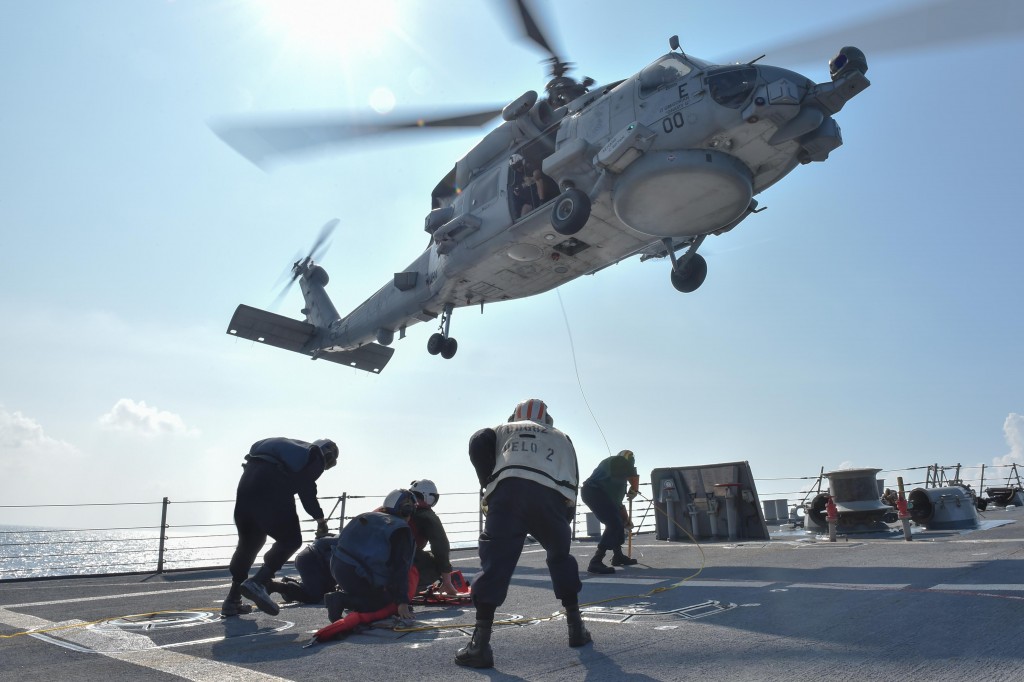
-Had this been done within 12 NM of Subi Reef, America’s commitment to Freedom of Navigation would be unambiguous.
Thus, in order for the USN to send the unequivocal message that it saw the 12 NM around Subi Reef as high seas, it had to have carried out at least one of those activities. Else, its transit would have been identical in form to that of an innocent passage, which is only required for territorial waters. Carrying out such a transit would therefore legitimize, or at least be viewed as legitimizing, the Chinese claim that Subi Reef has a 12 NM territorial sea. In so doing, Lassen’s voyage, far from contesting the Chinese position, would actually reinforce it by behaving in the same way it would have to in an actual territorial sea.
So how did Lassen actually behave during its transit? It appears more and more likely that Lassen in fact behaved exactly as she would in territorial waters. Sam LaGrone’s post on USNI News quotes US defence officials and sources as stating that Lassen carried out an innocent passage, though claiming it did not mean a recognition of the Chinese position. Lassen’s transit, then, was not any more a FONOP than any regular transit through another state’s territorial waters under the articles of UNCLOS.
If the United States wants to demonstrate its resolve on the issue, its FONOPs need to not only sail within 12 NM of a Chinese feature, but also involve activities prohibited under “innocent passage” conditions while in the area. Such activities can be as mundane as lowering a fishing lure over the side, or as visually impressive as launching a Seahawk or UAV.
As the US plans for further, more regular FONOPs in the South China Sea, America’s willingness to challenge China on the issue will manifest not in dramatic debates at the United Nations or stern press releases, but in the minute activities of the ships and sailors involved. Photographs and videos of such activities would go far to prove the United States’ unwillingness to compromise on Freedom of Navigation and gain the confidence of its regional allies. A strong and unambiguous message now can nip a problem in the bud before it can fester to point where actual violence may break out. To paraphrase Sun-Tzu, it is much better to defeat an enemy’s strategy than to defeat them in battle. Heading off the Chinese at their own norm-creation game now will decrease the opportunities for misunderstandings leading to violence in the future – but only if the message cannot be misinterpreted.
Timothy Choi is a PhD student at the University of Calgary’s Centre for Military & Strategic Studies. Interested in all areas of maritime security and naval affairs, he struggles everyday with the fact that he studies at an institution located hundreds of kilometres away from the nearest ocean. When not on Twitter (@TimmyC62), he can be found building tiny ship models and headbanging to some kind of northern European folk metal.
Should the U.S. Navy Help with the Med. Refugee Crisis?
A Modest Proposal to Help this Generation’s “Boat People”
By John T. Kuehn
First, this article may be too late. What do I mean? I mean that we—as in the global community and the United States in particular—may be too far behind the power curve to do something meaningful about helping the refugees fleeing across the sea from the Syrian Civil War-Islamic Thirty Year’s War raging in the Middle East. This is my way of saying I wish I had written this about six months ago when the problem was manifest to all. So why write at all? Something might be STILL done with forward deployed naval forces of the United States today, perhaps with like-minded maritime allies to help the unfortunate masses of humanity fleeing their homelands from a particularly cruel conflict. Even if it is too late for current policy, the trend of “boat people” fleeing war to a better life elsewhere has many precedents in history, especially the last one hundred years and it will most certainly occur again. This means that ringing the clarion now might contribute to effective humanitarian policy action in the future. So it is worth a try.
First, let us briefly review some relevant history on these sorts of refugee crises as they pertain to migration in unseaworthy craft in search of a better life on distant shores. Case one takes us back to 1975 and the late 1970s when the United States’ lost war in Vietnam resulted in the flight of the boat people of South Vietnam (and Cambodia, too) from the proletarian utopias established by the new Vietnamese government in Hanoi and the Khmer Rouge. The United States was caught napping somewhat on this one, too, but before long had started making efforts with naval assets based in the Western Pacific to help with this crisis. However, years later a particularly unfortunate incident occurred in the 1980s wherein the captain of a U.S. warship (the USS Dubuque) failed to render proper assistance to fleeing “boat people” who later survived to present evidence against him. We will return to this issue since it is a feature of the law of the sea that mariners must render aid to people in danger on the high seas. More recently Americans saw the flight of people from both Cuba and Haiti to the United States in the 1990s, fleeing various natural and man-made disasters in the Caribbean.
Why should the United States use its assets, especially its Navy, to help these people? There are three principle reasons: moral obligation, humanitarian, and practical. The practical value for the United States involves two factors, leadership and what, for lack of a better term, might be called “good press.” If the U.S. is to be a leader it must take the lead in areas where it claims an interest. By getting more involved and working with other states of the region while at the same time committing actual naval forces to help, we build partnerships, lead, and help. It is a win-win-win result.
From a moral standpoint we owe it to these people. Here is the causal logic—when the U.S.-led coalition invaded Iraq all those years ago we removed the government in power and destabilized the region. From that context Al Qaeda in Iraq (AQI) developed. During the final years in Iraq we estimated we had pretty much solved the problem of AQI, but instead it had simply transformed itself into the current Islamic State (ISIS). At the same time Syria fell into civil war, a conflict not unrelated to our actions in Iraq and has been further de-stabilized, especially since 2013, by an increasingly powerful and dangerous ISIS. The upshot is that some, not all, of these refugees can be traced to American policy choices, so there exists something of a moral obligation to help with the result of our, for lack of a better word, blundering in the Middle East.
Finally, we get back to the purely humanitarian reasons—the salvation of (mostly) innocent human life. Obviously things are being done, but there is little reason to allow people to helplessly drown or die of exposure at sea on un-seaworthy craft. They already think they can make it and so the arguments that they would not flee if they did not think someone would help are not only ill-informed, they are morally wrongheaded. In fact, the United States by simply having ships in the Eastern Mediterranean is obligated to “render assistance” should it run across people in distress on the high seas. Simply stationing ships on patrol in that area will naturally result in a requirement to render assistance because we certainly do not want any more Dubuques like we had in the South China Sea after the Vietnam War had ended.
As with any use of American taxpayer-funded projects, use of U.S. Navy assets must be judicious. Also, we must coordinate with partners and allies in the region, but rendering assistance on the high seas is part of international law and a moral imperative, more than one might think given our distance from the Eastern Mediterranean. However, if the United States is to use its Navy as the “sysadmin” of the global maritime regime, as Captain Peter Haynes discusses in his recent book on the “new maritime strategy,” then this sort of action and use of naval power is part of the responsibility that the mantle of maritime leadership confers. Or perhaps we no longer aspire to lead in this domain? I think not.
Dr. John T. Kuehn is the General William Stofft Chair for Historical Research at the U.S. Army Command and General Staff College CGSC). He retired from the U.S. Navy 2004 at the rank of commander after 23 years of service as a naval flight officer flying both land-based and carrier-based aircraft. He has taught a variety of subjects, including military history, at CGSC since 2000. He authored Agents of Innovation (2008), A Military History of Japan: From the Age of the Samurai to the 21st Century (2014), and co-authored Eyewitness Pacific Theater (2008) with D.M. Giangreco as well as numerous articles and editorials and was awarded a Moncado Prize from the Society for Military History in 2011. His latest book, due out from Praeger just in time for the 200th Anniversary of the Battle of Waterloo is Napoleonic Warfare: The Operational Art of the Great Campaigns.
The views are those of the author and do not reflect the official policy or position of the Department of the Army, Department of Defense, or the U.S. Government.

